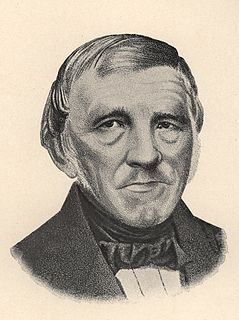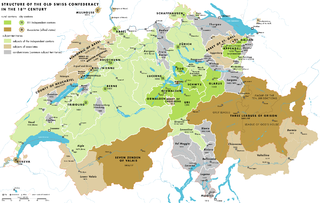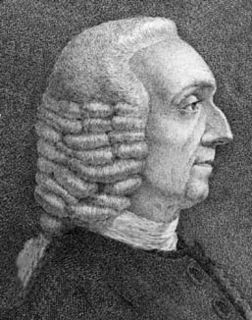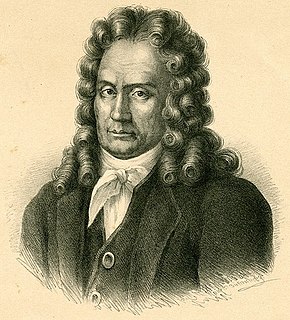Related Research Articles

Friedrich Wilhelm Bessel was a German astronomer, mathematician, physicist, and geodesist. He was the first astronomer who determined reliable values for the distance from the sun to another star by the method of parallax. A special type of mathematical functions were named Bessel functions after Bessel's death, though they had originally been discovered by Daniel Bernoulli and then generalised by Bessel.

Jacob Bernoulli was one of the many prominent mathematicians in the Bernoulli family. He was an early proponent of Leibnizian calculus and sided with Gottfried Wilhelm Leibniz during the Leibniz–Newton calculus controversy. He is known for his numerous contributions to calculus, and along with his brother Johann, was one of the founders of the calculus of variations. He also discovered the fundamental mathematical constant e. However, his most important contribution was in the field of probability, where he derived the first version of the law of large numbers in his work Ars Conjectandi.
The Bernoulli family of Basel was a patrician family, notable for having produced eight mathematically gifted academics who, among them, contributed substantially to the development of mathematics and physics during the early modern period.

Johann Franz Encke was a German astronomer. Among his activities, he worked on the calculation of the periods of comets and asteroids, measured the distance from the Earth to the Sun, and made observations of the planet Saturn.

Johann Bernoulli was a Swiss mathematician and was one of the many prominent mathematicians in the Bernoulli family. He is known for his contributions to infinitesimal calculus and educating Leonhard Euler in the pupil's youth.

Johann Jakob Balmer was a Swiss mathematician best known for his work in physics, the Balmer series of hydrogen atom.

The early modern history of the Old Swiss Confederacy and its constituent Thirteen Cantons encompasses the time of the Thirty Years' War (1618–1648) until the French invasion of 1798.

Tobias Mayer was a German astronomer famous for his studies of the Moon.

Johann Kies was a German astronomer and mathematician. Born in Tübingen, Kies worked in Berlin in 1751 alongside Jérôme Lalande in order to make observations on the lunar parallax in concert with those of Nicolas Louis de Lacaille at the Cape of Good Hope.

Elisabeth Catherina Koopmann-Hevelius is considered one of the first female astronomers. Originally from Danzig, Poland, she contributed to improve the work and observations done together with her husband Johannes Hevelius.

Astronomische Nachrichten, one of the first international journals in the field of astronomy, was established in 1821 by the German astronomer Heinrich Christian Schumacher. It claims to be the oldest astronomical journal in the world that is still being published. The publication today specializes in articles on solar physics, extragalactic astronomy, cosmology, geophysics, and instrumentation for these fields. All articles are subject to peer review.

Johann Albrecht Euler was a Swiss-Russian astronomer and mathematician. Also known as Johann Albert Euler or John-Albert Euler, he was the first child born to the great Swiss mathematician Leonhard Euler (1707–1783), who had emigrated [for the first time] to Saint-Petersburg on 17 May 1727. His mother was Katharina Gsell (1707–1773) whose maternal grandmother was the famous scientific illustrator Maria Sibylla Merian (1647–1717) and whose father was the Swiss Baroque painter Georg Gsell (1673–1740) who had emigrated to Russia in 1716. Katharina married Leonhard Euler on 7 January 1734 and Johann Albert would be the eldest of their 13 children.

Johann II Bernoulli was the youngest of the three sons of the Swiss mathematician Johann Bernoulli. He studied law and mathematics, and, after travelling in France, was for five years professor of eloquence in the university of his native city. In 1736 he was awarded the prize of the French Academy for his suggestive studies of aether. On the death of his father he succeeded him as professor of mathematics in the University of Basel. He was thrice a successful competitor for the prizes of the Academy of Sciences of Paris. His prize subjects were the capstan, the propagation of light, and the magnet. He enjoyed the friendship of P. L. M. de Maupertuis, who died under his roof while on his way to Berlin. He himself died in 1790. His two sons, Johann and Jakob, are the last noted mathematicians of the Bernoulli family.

Johann III Bernoulli, grandson of Johann Bernoulli and son of Johann II Bernoulli, was known around the world as a child prodigy.

The Mozart family were the ancestors, relatives, and descendants of Wolfgang Amadeus Mozart. The earliest documents mentioning the name "Mozart", then spelled "Motzhart" or "Motzhardt", are from the Bavarian part of Swabia.

Giovanni Francesco Mauro Melchiorre Salvemini di Castiglione FRS was an Italian mathematician and astronomer.

Laurentius Blumentrost was the personal physician to the Tsar, founder and first president of the Saint Petersburg Academy of Sciences, from December 7, 1725, to June 6, 1733.
Johann Jakob Burckhardt was a Swiss mathematician and crystallographer. He was an invited speaker at the International Congress of Mathematicians in 1936 in Oslo.

Jacques-André Mallet ; also Mallet-Favre; 23 September 1740 – 31 January 1790) was a Genevan mathematician and astronomer.
References
- ↑ Wilhelm Brüggenthies, Wolfgang R. Dick: Biographischer Index der Astronomie · Biographical Index of Astronomy. Acta Historica Astronomiae Vol. 26. Deutsch, Frankfurt am Main 2005, ISBN 3-8171-1769-8, S. 234.
- 1 2 Genealogie Huber
- ↑ ARI: Direktoren des Astronomischen Rechen-Instituts Archived 20 July 2007 at the Wayback Machine (bis 1874 der Berliner Sternwarte)
- ↑ Selbstzeugnisse Datenbank. Historisches Seminar Uni Basel.
- ↑ Emil A. Fellmann (1972), "Huber, Daniel", Neue Deutsche Biographie (in German), vol. 9, Berlin: Duncker & Humblot, pp. 689–690; ( full text online )